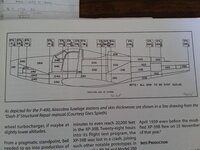GregP
Major
Way cool, ThomasP! Best P-63 pic I've seen for looking at engine location is the overhead view.
You can see the intake tube going into the internal supercharger housing perfectly. One of the main reasons we all know there is a bearer for the aux stage is that the intake to the internal S/C has rubber connections to the tube coming from the aux stage. That keeps it airtight, but won't support much weight. let along a couple of hundred pounds. The only other connection of any consequence is a very light driveshaft.
You can also see it is pretty wide right back to the bulkhead aft of the aux stage.
Nice pics.
You can see the intake tube going into the internal supercharger housing perfectly. One of the main reasons we all know there is a bearer for the aux stage is that the intake to the internal S/C has rubber connections to the tube coming from the aux stage. That keeps it airtight, but won't support much weight. let along a couple of hundred pounds. The only other connection of any consequence is a very light driveshaft.
You can also see it is pretty wide right back to the bulkhead aft of the aux stage.
Nice pics.


